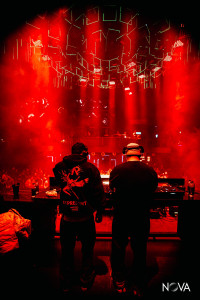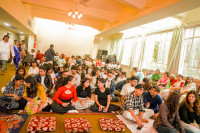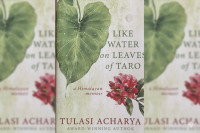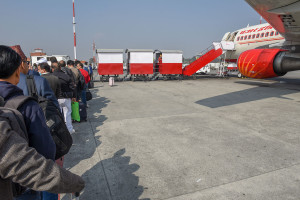Culture & Lifestyle
The revered month of Gunla
During the holy month of Gunla, age-old traditions and rituals adapt due to necessity and a need for convenience.
Shranup Tandukar
For Newa Buddhists, Gunla, which is the tenth month of the lunar calendar Nepal Sambat, is the holiest month in the entire year. Gunla this year started from August 9 and will end on September 7. A typical day during Gunla starts with the echoes of traditional Newa musical instruments like dha baja (a drum-like musical instrument), animated crowds of people forming a procession, and melodies of Buddhist hymns and chants wafting through every nook and corner of bahas and bahis.
“As a child I noticed an increase in the number of devotees at bihars as well as an increase in religious sermons during a particular month. That’s how I knew about the month of Gunla,” says Deepak Bajracharya, a 54-year-old priest and member of Hiranya Varna Mahabihar (The Golden Temple).
Since last year, due to the Covid-19 pandemic, the intensity and fervour usually bursting during Gunla month has died down; the dha baja remains unplayed, the scriptures unread, and only the essential rituals carried out. However, the change in age-old traditions and rituals during Gunla aren’t only due to the recent pandemic, they have also slowly been altering for convenience.
Behind the festivities and into the origin
There are two differing opinions about the celebration time period of Gunla; some regard it as the ninth month while others regard it as the tenth month.
Alok Siddhi Tuladhar, a heritage conservationist, believes that this confusion stems from the fact that ‘gu’ means ‘nine’ and ‘la’ means ‘month’ in the Nepalbhasa. However, the lunar calendar of Nepal Sambat designates Gunla as the tenth month.
He adds, “The origin of Gunla celebration may be related to the ancient practice of Buddhist priests and monks spending a month in a forest for meditation and spiritual growth. The common people who weren’t able to spend a month inside the forest would instead meditate and celebrate Buddhist rituals during this month which may have started the celebration of Gunla.”
One of the other theories for the origin of this month-long celebration is connected to the agrarian history of Kathmandu Valley. Patan resident and Dha baja performer Shital Shakya says, “I heard from gurus and priests that in the past, before urbanisation of the Valley, Shrawan month signified a lull in field and farm works. During this month, the society filled with farmers had free time to devote to religious practices and spiritual awakening.”
Tuladhar agrees that there may have been a seasonal reason for the origin of Gunla. He asserts that Kathmandu Valley denizens have had a deep appreciation for ancestors and nature since ancient times.
Significance of Gunla
Narayan Mulik, a priest of Bikramsila Mahabihar in Thabahil, says that Gunla is an auspicious month which is not only important for Newa Buddhists but “all Buddhists from different ethnicities and castes.”
Celebrations during the Gunla month are as abundant as the bahas and bahis in the alleyways of Kathmandu Valley. Culture expert Satya Mohan Joshi in his book ‘Legends of Lalitpur and Related Tales’ writes that “The continuous flow of interrelated festivals during Gunla is literally a way of life for the Newa communities of Lalitpur. These festivals, unique in their own way and picturesque at all times, are based on mythology and religion and tinged with local characteristics.” Buddhist priests around Patan also believe that Gunla probably became the holiest month because of the different festivals and celebrations that fall on it.
Swayambhu, the focal point of Newa Buddhism, also plays a vital role during the Gunla month. The Swayambhu stupa, regarded as one of the most sacred Buddhist sites in the Valley, hustles and bustles with throngs of devotees during this month.
For the Newa Buddhists unable to visit Swayambhu, a visit to their local bihars during the Gunla month is the next best option.
At the crack of dawn every day of Gunla, Gyani Maharjan makes a trip to Bikramsila Mahabihar from her residence in Lainchaur. She says that she hasn’t been able to visit Swayambhu for ten years due to old age and she has settled on visiting nearby bihars instead. “Gunla is a very important month for Buddhists. There are lots of celebrations with music and festivities all around during this month and I enjoy taking part. However, I cannot read the scriptures myself so I visit bihars and listen to the religious sermons and hymns.”
.jpg)
Some of the popular celebrations during Gunla
Festivals and traditions during Gunla are varied; some are celebrated far and wide while some can even be limited to a specific locality or baha or bahi.
One of the popular festivals of Gunla, Panchadaan is celebrated on the thirteenth day of the waning moon near the end of Gunla in Kathmandu. In Patan, Panchadaan, which fell on August 16 this year, is celebrated earlier than in Kathmandu and Bhaktapur.
During Panchadaan, households showcase their statue of Dipankara Buddha and donate five grains—paddy, rice, wheat, green peas, and soybean—along with salt to incoming priests and monks while the priests and monks bless the Dipankara Buddha statues.
Shital fondly remembers the past Panchadaan celebrations in her locality. “The Dipankara Buddha statues in front of every house looked like personal spiritual guardians. I believe that donating the grains during Panchadaan signifies the revered Buddhist tradition of altruism.”
During the celebration of ‘Bogiwanegu’ or ‘Baghi’, devotees visit all the stupas and Buddhist monasteries similar to the activity in Matya, which is derived from the words ‘mata’ meaning light and ‘ya’ meaning festival. During Matya, devotees wake up early in the morning around 4 am and visit almost every stupa and sacred area in Patan’s different bahas and bahis within a day with a procession of music and festivity. The devotees offer candles and butter lamps to stupas and Buddha statues. Deepak shares that “devotees visit almost 1,000 stupas in Patan area.”
Tuladhar believes that this tradition acts as a way to conduct an ‘annual census’ of Buddhist monuments. “It might have been a rudimentary method of noting down the condition of all the stupas,” says Tuladhar. Patan-based priest Deepak also agrees that Matya celebration allows devotees to gauge the condition of stupas and plan for renovations if needed.
Unlike Matya, Bogiwanegu is only carried out during the night so the festival spans several days.
For Bogiwanegu, Deepak shares that the nightfall timing of the pilgrimage is due to the deep reverence of Buddhists towards stupas. He says, “The stupa structure is so sacred during Gunla that even stepping on the shadows of the stupa can be considered immoral so during the ‘baghi’ festival, devotees make pilgrimage only during the night to avoid shadows. When the sun comes up, they stop their pilgrimage and when the sun goes down, they continue their pilgrimage.”
Evolution of the month-long festival
“It was a question of survival[for the celebration of Gunla] but now there is no such worry,” says Tuladhar.
He reminisces about a worrying trend during his teenage years when he would be accompanied by just two to three friends while going to the Swayambhu during Gunla. But now, he cheerfully says that he has noticed a positive trend of increased youth participation during the recent years.
Hem Ratna Bajracharya, a charya dance instructor and priest of The Golden Temple, says that musical instruments and dancing entice youths to join these religious and cultural celebrations. “Some people only join charya classes for dancing. It’s not a bad thing though.” He says that he incorporates the religious and cultural origin and significance of these dances during classes so that the youths also have a taste of religion and culture.
Deepak agrees that activities like playing musical instruments, singing, and dancing attracts the youths but religious sermons and preachings do not attract them at all. “Youths immediately distance themselves when they hear even a faint hint of a sermon,” says Deepak.
A need for convenience also became a pressing matter for adaptations. The tradition of devotees walking to Swayambhu accompanied by playing of musical instruments and reciting of hymns during early dawn is slowly adjusting to modern alternatives. Bhagwan Shakya, a resident of Itum Baha, shares that people have now started to rent out microbuses so that the whole community can reach Swayambhu together conveniently.
During Panchadaan, most households would showcase a statue of Dipankar Buddha, give alms, and receive blessings. But Tuladhar laments that this tradition has been moulded into a joint activity in areas like Ason where individual houses band together and create a communal donation area instead.
“In the name of convenience and necessity, we might be forgetting the meaning of the festival,” says Tuladhar.
On a positive note, during recent musical processions, Tuladhar notes that the use of clarinets is losing popularity. He shares that community members are being trained and made to participate with a bansuri instead of a clarinet, an imported musical instrument. He believes that this helps to preserve the ancient culture and traditions of our own community.
The recent pandemic has also forced these traditions and celebrations to adapt—the extent differing from baha to baha, bahi to bahi, and family to family. Almost all of the bahas in the Kathmandu Valley are devoid of the sweet melody of musical instruments and the essential rituals are being performed in a toned down scale.
In Kathmandu’s Itum baha, a daily chant of Buddhist hymns can be heard early in the morning during Gunla. A crowd of around 15 people gather in the baha, start chanting hymns and verses from thin photocopies of Buddhist scriptures, then move on to encircle the whole community while reciting hymns.
Bhagwan, also one of the members of this crowd, says, “Last year, we didn’t do anything due to the fear of the pandemic. But this year, we decided to at least continue with our daily gatherings in the morning.”
The baha comes alive during the morning but as the morning gives way to the day, the small crowd of people start to dwindle along with life in the baha. “If we do not give continuity to our culture and traditions, then people who come looking to know about our culture will return empty-handed,” he says. “If we do not continue, who else will?”




 17.12°C Kathmandu
17.12°C Kathmandu















